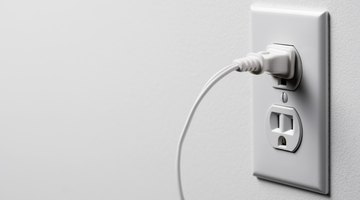2-Prong Electric Plug Wiring
Electric plugs only need two prongs, and that's all many of them have. One prong connects to the hot wire, which is the live circuit wire, and one connects to the neutral wire, which is the one that completes the electrical circuit.

Some 120-volt plugs have a third prong for grounding the appliances they serve, and plugs for 240-volt appliances, which require two hot wires, have four prongs. The basic 120-volt plug, however, has two prongs.
Invention of the Electric Plug
The flat-blade two-prong plug familiar to Americans essentially is the same design as the "separable attachment plug" invented by Harvey Hubbell in the early 20th century. Before Hubbell introduced his invention, electrical appliances -- which, at the time, mostly included lightbulbs -- had to be wired to a power source each time anyone wanted to use one. By the time Hubbell introduced his plug, the Westinghouse Company, which was the most important supplier of electric power in the United States, had chosen to use alternating current instead of direct current, which is more difficult to transmit. Thus, the prongs of Hubbell's plug became "hot" and "neutral" instead of "positive" and "negative."
Electric Circuit
The power company transmits electricity along the power lines to a transformer outside your house. That transformer steps down the voltage, and power comes into the panel in the form of two hot cables at voltage of 240 volts relative to each other. That means each cable is at a voltage of only 120 volts relative to a neutral wire that runs from the panel back to the transformer. This neutral wire connects to a bus, and all 120-volt outlets in the house also connect to that bus. Therefore, the 120-volt circuit you plug into consists of a wire from one of the hot buses and a wire from the neutral bus.
Polarized Plugs
The hot wire connects to the terminal screw on one side of an outlet, and the neutral wire connects to the screw on the other side; electricity always flows from hot to neutral. Older two-prong plugs and outlets weren't polarized, meaning you could insert the plug either way into the outlet and change the direction of the electricity flow through your appliance. This can damage modern electronic equipment, however, because some components, such as diodes, are unidirectional. Contemporary plugs and outlets, therefore, have one prong bigger than the other so you can only insert the plug one way. The larger prong connects to the neutral terminal.
Grounding Pin
One of the most important innovations to the electric plug occurred when Philip F. Labre added the ground pin in 1928. That pin connects to a ground wire, which protects users from inadvertently grounding the circuit through their bodies. Labre's design became the standard one for electrical receptacles, but many light-duty contemporary appliance and lamp plugs don't have a grounding pin. This is because the appliances and lamps are double-insulated; there is no danger of grounding one with your body. Many industrial appliances, however, such as saws and large heaters, as well as appliances intended for outdoor use, have plugs with grounding pins.
The Drip Cap
- Electric plugs only need two prongs, and that's all many of them have.
- The flat-blade two-prong plug familiar to Americans essentially is the same design as the "separable attachment plug" invented by Harvey Hubbell in the early 20th century.
- Older two-prong plugs and outlets weren't polarized, meaning you could insert the plug either way into the outlet and change the direction of the electricity flow through your appliance.
- The larger prong connects to the neutral terminal.
- Labre's design became the standard one for electrical receptacles, but many light-duty contemporary appliance and lamp plugs don't have a grounding pin.
References
Writer Bio
Chris Deziel has a bachelor's degree in physics and a master's degree in humanities. Besides having an abiding interest in popular science, Deziel has been active in the building and home design trades since 1975. As a landscape builder, he helped establish two gardening companies.
Photo Credits
- Jupiterimages/Polka Dot/Getty Images
- Jupiterimages/Polka Dot/Getty Images
More Articles



